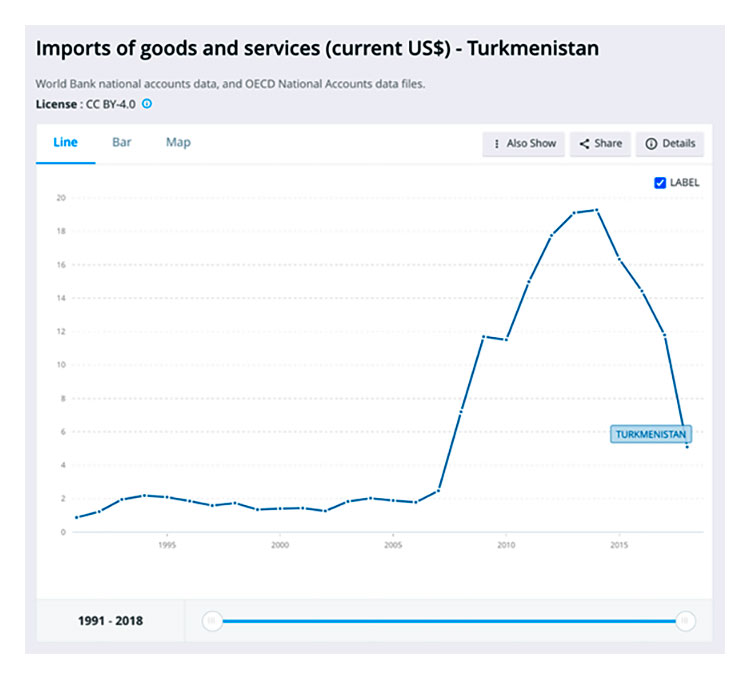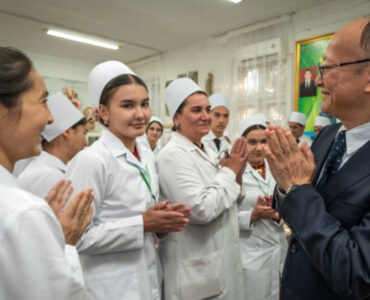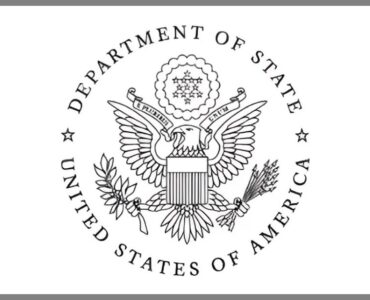Summary
Since 2015 Turkmenistan has been implementing import-substitution policies which came into force during the foreign currency shortages and the emergence of the black-market exchange rate. In this policy brief, we will review the advantages and disadvantages of import substitution policies and argue that they threaten fair competition in domestic markets and make Turkmenistan’s industrial sector inefficient and uncompetitive in international markets.
Background
In 2015, Turkmenistan adopted the state program “Approval of the state program for the production of substitutes for imported goods in Turkmenistan” with the aim of creating import-substituting industries, strengthening the positive balance of foreign trade, creating new jobs, and increasing household incomes. The country aimed at achieving import substitution industrialization (ISI) along with the gradual transition to the market economy “by comprehensively supporting small and medium-sized businesses as well as entrepreneurial initiatives” (Turkmenportal).
Under this program, which is implemented by the Union of Industrialists and Entrepreneurs, Turkmenistan plans to build 81 factories. The law, which is available online (only in Turkmen), lists all 81 factories, the due dates, the annual capacity of production, and the budget. The factories are supposed to produce a wide range of construction, chemical, household, and other goods with local raw materials.
All 81 of these factories were planned to be completed by 2020 at the latest with 617.6 million manats (176.5 mln USD) to be invested in total. However, there is neither publicly available database to track the status and stage of development of these projects, nor action plan that states how to achieve the import substitution.
Overview of economic policies
The economic policies that have been implemented in Turkmenistan since 2015 show country’s strong protectionist trade policy stance. Some of the most important policies are highlighted below:
- Restricting the free exchange of foreign currencies
Turkmenistan severely restricted the free exchange of foreign currencies since 2016, which led to the emergence of the black-market exchange rate (Effects of Turkmenistan’s dual exchange rates by Progres.online). Importers wishing to import finished products from abroad do not have access to foreign currencies and they can only acquire them through the black market since 2016.
- Imposing taxes on imports through tariffs and duties
Turkmenistan imposed import duties for many products imported from abroad. The State customs service of Turkmenistan released its import duties for products imported to Turkmenistan. These duties are mostly levied per 1kg of imported products, while other products had the percentage amount imposed on them. There is no mention of the average value or the percentage of import duties. Most of these import duties are levied on industrial raw materials and agricultural products. Products exempt from import duties are: all types of meat, vegetable oil, butter, matches, seed wheat, rice, and other cereals; the products of the mill industry (except for I and II quality of flour); sugar and seed eggs.
- Subsidizing domestic firms
The state subsidizes domestic companies engaged in the production of goods with the aim of replacing imports. The subsidies are provided by giving access to the cheap exchange rate, cheap credits, and allocation of land for production as the state owns all the land in the country. The state ownership of land also prevents the inflow of foreign direct investments (FDI) into the economy, which contributes to the growth of the economy.
What were the results of these policies in Turkmenistan?
Trade: Since ISI policies started only 7 years ago in 2015, it is too early to see the results of such policies. Nonetheless, there is no publicly available data to show whether ISI policies achieved their goals in replacing the share of imported goods with domestic ones. The only data which is available online is the total annual value of imported goods and services. Since the ISI programs, imports declined from $16.3 billion in 2015 to $5.1 billion in 2018 (World Bank). Import data for years beyond 2018 have not been updated on the World Bank’s website.
According to the data from SESRIC, Turkmenistan’s annual imports amounted to 3.0 billion USD in 2019, 3.2 billion USD in 2020, and 4.03 billion USD in 2021.
Source: World Bank;
Despite the significant decline in annual imports since 2015, it cannot be safely concluded that it occurred due to the ISI policies. There is a significant correlation between the exchange rate and import values. There were fewer restrictions on currency exchanges between 2008 and 2016 with a fixed exchange rate of 2.85 to 3.5 manat/USD. At the same time, the country generated higher incomes from the exports of natural gas. Therefore, imports grew exponentially during this period from 2.5 billion USD in 2007 to 19.3 billion in 2014, an 8-fold increase (World Bank). Later, banks stopped selling foreign currencies in 2016 and imports declined at a similar rate due to the shortage of foreign currencies as well as their high value on the black market.
Donate to support Turkmen analysts, researchers and writers to produce factual, constructive and progressive content in their efforts to educate the public of Turkmenistan.
SUPPORT OUR WORKAccording to Yuri Aronsky, the head of the Union of Economists of Turkmenistan, as a result of the import substitution policies implemented since 2015, the total volume of imported food products decreased by 24% in 2020 compared to the previous year (2019) due to the local production of similar products by Turkmen enterprises. However, it might as well be the result of the restrictive measures during pandemic as Turkmenistan closed its land borders for cargo trucks carrying goods into the country in 2020, which could have led to decreased imports.
Employment: One of the main goals of ISI policies is to increase employment rates as a result of the newly created factories through protectionism, which can provide new jobs to people. According to the literature, protectionist policies do not increase employment. These policies only protect jobs in those industries and firms that cannot sustain themselves under fair competition. The state Committee on Statistics of Turkmenistan does not publicly share the changes in employment rates. Based on the modeled estimates of ILO, the unemployment rate in the country has increased from 4.1% in 2015 to 5.1% in 2021. The youth unemployment rate (ages 15-24) also rose from 9.8% in 2015 to 11% in 2021. However, alternative sources claim that the unemployment rate in the country is close to 50%, though they are not directly linked to ISI policies.
Prices: The literature review on import substitution policies shows that trade restrictions result in higher prices for consumers. Unfortunately, the inflation rate is not available on the website of the state Committee on Statistics of Turkmenistan. Based on the IMF’s projected data, the average annual inflation rate in Turkmenistan increased from 7.4% in 2015 to 17.5% in 2022. Alternative sources such as those from Prof. Hanke show that it reached as high as 55% in 2021. However, the policy brief prepared by progres.online concluded that high inflation in recent years was mostly driven by the restrictions on the exchange of foreign currencies.
Analysis of ISI policies in Turkmenistan
While there are no metrics or indicators to reliably measure the progress with regards to ISI policies in Turkmenistan, the literature review provides a roadmap to assess the advantages and disadvantages of such policies.
- Restrictions on the exchange of foreign currencies can lower the share of imported goods due to the problems of acquiring foreign currencies for importers. In return, it can create opportunities for domestic producers to step in and replace the share of imports. The black market rate is valued at around 19.3 manat as of this publishing, which is almost 6 times more expensive compared to the official exchange rate of 3.5 manats/USD. Such a high black-market premium for foreign currencies significantly raises the prices of imported products and makes their prices uncompetitive against domestic producers. However, such restrictions come at a significant cost for consumers as they face fewer options and higher prices for imported goods, which can push many families into poverty.
- The visible results of trade restrictions in the form of import tariffs and duties can help reduce the share of imported goods, which is seen by some policymakers as a good policy tool to strengthen the domestic industry and employment rates. However, based on economic theories and empirical evidence, import restrictions reduce trade volumes, increase the price of goods for consumers and risk retaliation from a trading partner. In the long-run, free trade with fewer restrictions have net benefits for society and benefits from international trade clearly outweigh the potential costs. Trade restrictions limit the choice of products that consumers can buy and raise their prices. The US agency International Trade Administration reports that “import duties and taxes imposed by Turkmenistan are significant barriers to trade”.
- While state subsidies can help the country to achieve industrialization in the short and medium term, they might result in unintended consequences, which will negatively impact the economy. There is no clear guidance on how state bureaucrats decide which domestic firm to help. If the state subsidizes some domestic firms and not others, then it harms domestic competition. Equally, if the state subsidizes the whole industry, then it harms the overall competition against foreign producers (OECD 2019). Secondly, due to the widespread occurrence of corruption in public sector in Turkmenistan, the selection of firms to receive state subsidies will most likely result in corruption and rent-seeking as it happened in other countries. Thirdly, it creates problems for the competitiveness of the industrial sector in the long run due to the reliance of domestic firms on state subsidies. Therefore, the country should rely on the principles of a market economy, in which several domestic and foreign firms fairly compete to provide goods and services to consumers.
EBRD‘s report on Turkmenistan states “that waste of resources could be reduced, and welfare gains could be achieved if trade policies were based on better market research and a more market-based approach”. IMF during its visit to Turkmenistan in 2019 noted that phasing out import-substitution policies will help make exports more competitive and help diversify the economy.
Experiences of other countries with ISI policies
ISI policies were widely implemented in the 1950s in Latin America and South Asia with the aim of developing domestic industries and gaining self-sufficiency. However, it was evident by the 1960s that such policies led to highly protected and inefficient domestic industries along with reduced exports and lower foreign exchange earnings, notes Peterson Institute for International Economics.
The World Bank paper notes that ISI policies did not work in the Middle East and North Africa (MENA) and resulted in an inefficient subsidy-based private sector causing higher prices for tradable goods. The IMF paper states that ISI policies contributed to achieving faster industrial expansion in developing countries. However, the paper concluded that the economic costs have often been substantially greater than the benefits and worsened the outlook for long-term industrial development.
Economic theories show that countries will be better off if they produce something based on their comparative advantage. For instance, if businesses in Turkmenistan can produce certain products more efficiently and at a lower opportunity cost than others, then they should produce those products hence acting based on their comparative advantage. If some goods are more expensive to produce at home, then the country will be better off importing them from abroad.
Conclusions and recommendations
While the ISI policies have good intentions of developing domestic firms and new jobs, as discussed above, although imports declined, the unemployment and prices increased. Based on the past experience of other developing countries and Turkmenistan’s weak institutional capacities and endemic corruption, the country might end up having inefficient and unproductive domestic industrial firms dependent on state subsidies. The experience of other countries also shows that better results can be achieved if countries adhere to the principles of free trade, which allows for competition between domestic and foreign firms.
Alternatively, the government of Turkmenistan can switch to the export-led industrialization policies. Based on the past experiences of other countries building industrialization with the aim of exports can create more efficient and productive domestic firms capable of competing in the world market. Export-led industrialization has the capacity to both create jobs, trade at foreign markets and fairly compete with importers to supply goods and services in the domestic market. Export-oriented growth can be achieved along with the WTO principles of trade liberalization and free trade. The World Bank paper also argues that export-oriented industrialization has advantages over import substitution strategies.
Additional recommendations to achieve long-term industrialization without protectionist policies include removing restrictions on currency exchanges, advancing human capital through investing in high-quality education, international collaborations, a free flow of information and increasing the level of economic freedom to increase the number of businesses, which will pave the way for the creation of new jobs.







